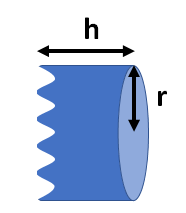Sometimes for things like conditioning a new column, re-equilibrating after a sample run, or changing mobile phases, you’ll see protocols written in terms of “column volumes.” You may also want to calculate the void volume of a column to determine the column contribution to the system dwell volume.
The void volume of a column is also referred to as the dead volume, the dwell volume, or simply the column volume. Whichever way it’s referred to, this volume means the volume of the column hardware minus the volume occupied by the particles packed inside. So, let’s start with calculating the volume of the column hardware.
Fortunately, the interior space of an LC column is just a cylinder – so we can calculate the volume the same way we would for any other cylinder.
Where h is usually the height of the cylinder, here it’s the column length. R is still the radius or half of the column diameter. So the volume of a 2.1 × 150 mm column is about 520 mm3 (π × 0.105 mm × 0.105 mm × 150 mm), which is 0.52 cm3 or 0.52 mL (remember 1 cm3 = 1 mL!). Just remember to use the same units for the length and the radius of your column – you’ll be off by an order of magnitude if you use millimeters for the radius and centimeters for the length!
(Side note, if you have Google handy – search for “volume of a cylinder” for a calculator where you can simply type in the radius (half the i.d.) and length (height) of your column.)
Now we need an estimation of the volume occupied by the packing material, which will be slightly different for every type and size of particles used. This volume is often thought of as a percentage of the cylindrical volume we calculated previously. Some column vendors may share this information, but often, it will be considered proprietary. If you only need an estimate, 60% of the cylindrical volume is a reasonable assumption for the void volume of the column. However, if you need a precise value you are best off measuring it. But I’ll leave you with a quick rule of thumb that works for many (though not all) of our columns at Agilent, the void volume of a 4.6 mm i.d. column is approximately 0.5 mL per 50 mm, and the void volume of a 2.1 mm i.d. column is roughly 0.1 mL per 50 mm. So, a 4.6 × 100 mm column will have a void volume of about 1.0 mL, and a 2.1 × 100 mm column will have a void volume of about 0.2 mL.
Talk to you soon,
Anne
Keywords: Bio columns, liquid chromatography, AdvanceBio blog
Or you can use this calculator:
Norbert



